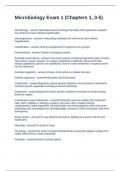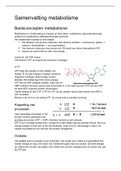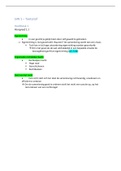Microbiology Exam 1 (Chapters 1, 3-5)
Microbiology - answer Specialized area of biology that deals with organisms ordinarily
too small to be seen without magnification.
Microorganisms - answer A living thing ordinarily too small to be seen without
magnification.
Classification - answer Orderly arrangement of organisms into groups.
Nomenclature - answer System of assigning names.
Binomial nomenclature - answer Two-name system of naming organisms (Latin, Greek).
Two names: Genus, species. It's always underlined or italicized. Genus first letter
always capitalized; species not capitalized. Once it's been mentioned, the genus name
can be shortened.
Acellular organisms - answer Viruses. Exist without a cellular structure.
Cellular organisms - answerProkaryotes and Eukaryotes.
Prokaryotes - answerOrganisms whose genetic material is not enclosed in membrane
and lack specific organelles including a nucleus (bacteria).
Eukaryotes - answerOrganisms whose genetic material is enclosed in nucleus (fungi,
protozoa, algae).
Prokaryotes versus Eukaryotes - answerProkaryotic cells are smaller than eukaryotic
cells, and in addition to lacking a nucleus, they lack other complex internal
compartments called organelles. All prokaryotes are microorganisms while only some
eukaryotes are microorganisms (including algae, protozoa, molds and yeasts- and even
anthropods).
Binary fission - answerThe way bacteria reproduce. Splitting of a parent cell into two
equal parts.
Mycology - answerThe study of fungi.
Phycology - answerThe study of simple photosynthetic eukaryotes (algae) ranging from
single celled forms to large seaweeds.
Pathogen - answerDisease causing agents.
,Genetic engineering - answerManipulates the genetics of microbes, plants, and animals
for the purpose of creating new products and genetically modified organisms.
Recombinant DNA - answerSwitch DNA from one organism to another to design new
organisms.
Lactic acid bacteria - answerDairy products, yogurt and cheese.
Curds - answerSolid chunks of day old milk, (fats and proteins etc. used in cheese) and
whey (mostly water). A gallon of milk yields only about 1.25 pounds of cheese (weight
lost is water).
Whey - answerLiquid part of day old milk, mostly water.
Rennin - answerTurn caseinogens to casein.
Curdling - answerProducts cause milk to separate into curds (the milk solids, fats,
proteins, etc.
Scientific method - answerApproach taken by scientists to explain a certain natural
phenomenon.
Hypothesis - answerA tentative explanation or statement to account for what is
observed or measured.
Theory - answerHypothesis backed by growing data.
Spontaneous generation - answerLife can rise from nonliving material.
Cell theory - answerAll things are made of cells.
Biogenesis - answerthe production of living organisms from other living organisms
Fermentation - answerOrganisms convert sugar into alcohol or acid (vinegar). Using
bacterial/fungal enzymes, convert food substrate from one form to another. Aid in slow
food spoilage. Foods use it for flavor and other properties. Fermentation products
include Lactic acid, acetic acid, yeast, etc.
Pasteurization - answerTo kill organisms by heat, some spoiling agents still stay.
Germ theory of disease - answerTheory that microbes can invade other organisms and
cause diseases.
Koch's postulates - answerSet of procedures to determine if a microbe causes a certain
disease. Verified the germ theory of disease.
, Aseptic technique - answerAimed at reducing microbes in a medical setting and
preventing wound infections. Lister proposed the idea of aspetic techniques and the
importance of hand washing and equipment sterilization.
Chemotherapy - answerTreatment of disease by the use of chemical substances. Now
problem with drug resistance.
Synthetic drugs - answerChemical substances made in a lab.
Antibiotics - answerChemical substance made by microbes.
General sizes of macroscopic organisms? - answer1 mm
Size of Microscopic organisms? - answer1 um to 100 um
Size of Viruses? - answer10 nm to 100 nm
What are the 3 domains used in the Woese-Fox system of classification? -
answerBacteria, Archaea, Eukarya.
Which domain are fungi members of? - answerEukarya
Which domain are Protozoa? - answerEukarya
Which domain are Algae? - answerEukarya
Which domain are E. coli? - answerBacteria
Which domain are Viruses? - answerNeither
Viruses - answerNeither prokaryote or eukaryote; acellular. Very small (nm). Need an
electron microscope to see them. Parasite. Core/caspid contains nucleic acids and a
protein coat. Some envelope around caspids.
Bacteria - answerProkaryote. All are microbes. Has a cell wall made up of Eubacteria
peptidoglycan. Absorb nutrition. Reproduce by binary fission. Unicellular. Commonly
found in biofilms.
Algae - answerUnicellular, some are multicellular. Reproduce asexually and sexually.
Nutrition by photosynthesis. Cell wall made of cellulose.
Fungi - answerSome are unicellular, some are multicellular. Nonmotile. Reproduce by
asexual and sexual reproduction. Cell wall made of chitin. Fungi digest outside then
ingest, absorb by release enzymes into environment. Cell membrane made of
ergosterol instead of cholesterol.
Microbiology - answer Specialized area of biology that deals with organisms ordinarily
too small to be seen without magnification.
Microorganisms - answer A living thing ordinarily too small to be seen without
magnification.
Classification - answer Orderly arrangement of organisms into groups.
Nomenclature - answer System of assigning names.
Binomial nomenclature - answer Two-name system of naming organisms (Latin, Greek).
Two names: Genus, species. It's always underlined or italicized. Genus first letter
always capitalized; species not capitalized. Once it's been mentioned, the genus name
can be shortened.
Acellular organisms - answer Viruses. Exist without a cellular structure.
Cellular organisms - answerProkaryotes and Eukaryotes.
Prokaryotes - answerOrganisms whose genetic material is not enclosed in membrane
and lack specific organelles including a nucleus (bacteria).
Eukaryotes - answerOrganisms whose genetic material is enclosed in nucleus (fungi,
protozoa, algae).
Prokaryotes versus Eukaryotes - answerProkaryotic cells are smaller than eukaryotic
cells, and in addition to lacking a nucleus, they lack other complex internal
compartments called organelles. All prokaryotes are microorganisms while only some
eukaryotes are microorganisms (including algae, protozoa, molds and yeasts- and even
anthropods).
Binary fission - answerThe way bacteria reproduce. Splitting of a parent cell into two
equal parts.
Mycology - answerThe study of fungi.
Phycology - answerThe study of simple photosynthetic eukaryotes (algae) ranging from
single celled forms to large seaweeds.
Pathogen - answerDisease causing agents.
,Genetic engineering - answerManipulates the genetics of microbes, plants, and animals
for the purpose of creating new products and genetically modified organisms.
Recombinant DNA - answerSwitch DNA from one organism to another to design new
organisms.
Lactic acid bacteria - answerDairy products, yogurt and cheese.
Curds - answerSolid chunks of day old milk, (fats and proteins etc. used in cheese) and
whey (mostly water). A gallon of milk yields only about 1.25 pounds of cheese (weight
lost is water).
Whey - answerLiquid part of day old milk, mostly water.
Rennin - answerTurn caseinogens to casein.
Curdling - answerProducts cause milk to separate into curds (the milk solids, fats,
proteins, etc.
Scientific method - answerApproach taken by scientists to explain a certain natural
phenomenon.
Hypothesis - answerA tentative explanation or statement to account for what is
observed or measured.
Theory - answerHypothesis backed by growing data.
Spontaneous generation - answerLife can rise from nonliving material.
Cell theory - answerAll things are made of cells.
Biogenesis - answerthe production of living organisms from other living organisms
Fermentation - answerOrganisms convert sugar into alcohol or acid (vinegar). Using
bacterial/fungal enzymes, convert food substrate from one form to another. Aid in slow
food spoilage. Foods use it for flavor and other properties. Fermentation products
include Lactic acid, acetic acid, yeast, etc.
Pasteurization - answerTo kill organisms by heat, some spoiling agents still stay.
Germ theory of disease - answerTheory that microbes can invade other organisms and
cause diseases.
Koch's postulates - answerSet of procedures to determine if a microbe causes a certain
disease. Verified the germ theory of disease.
, Aseptic technique - answerAimed at reducing microbes in a medical setting and
preventing wound infections. Lister proposed the idea of aspetic techniques and the
importance of hand washing and equipment sterilization.
Chemotherapy - answerTreatment of disease by the use of chemical substances. Now
problem with drug resistance.
Synthetic drugs - answerChemical substances made in a lab.
Antibiotics - answerChemical substance made by microbes.
General sizes of macroscopic organisms? - answer1 mm
Size of Microscopic organisms? - answer1 um to 100 um
Size of Viruses? - answer10 nm to 100 nm
What are the 3 domains used in the Woese-Fox system of classification? -
answerBacteria, Archaea, Eukarya.
Which domain are fungi members of? - answerEukarya
Which domain are Protozoa? - answerEukarya
Which domain are Algae? - answerEukarya
Which domain are E. coli? - answerBacteria
Which domain are Viruses? - answerNeither
Viruses - answerNeither prokaryote or eukaryote; acellular. Very small (nm). Need an
electron microscope to see them. Parasite. Core/caspid contains nucleic acids and a
protein coat. Some envelope around caspids.
Bacteria - answerProkaryote. All are microbes. Has a cell wall made up of Eubacteria
peptidoglycan. Absorb nutrition. Reproduce by binary fission. Unicellular. Commonly
found in biofilms.
Algae - answerUnicellular, some are multicellular. Reproduce asexually and sexually.
Nutrition by photosynthesis. Cell wall made of cellulose.
Fungi - answerSome are unicellular, some are multicellular. Nonmotile. Reproduce by
asexual and sexual reproduction. Cell wall made of chitin. Fungi digest outside then
ingest, absorb by release enzymes into environment. Cell membrane made of
ergosterol instead of cholesterol.




